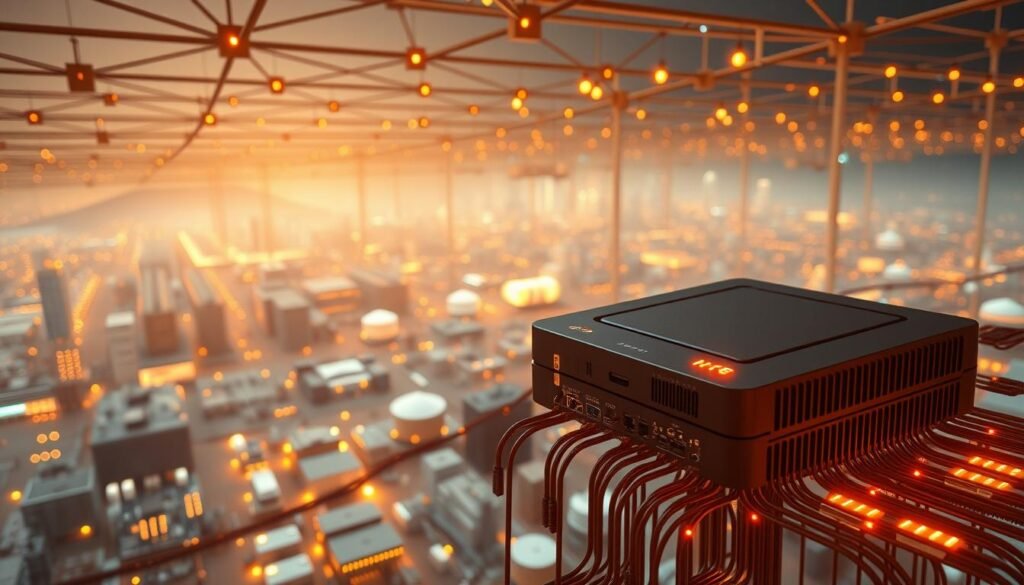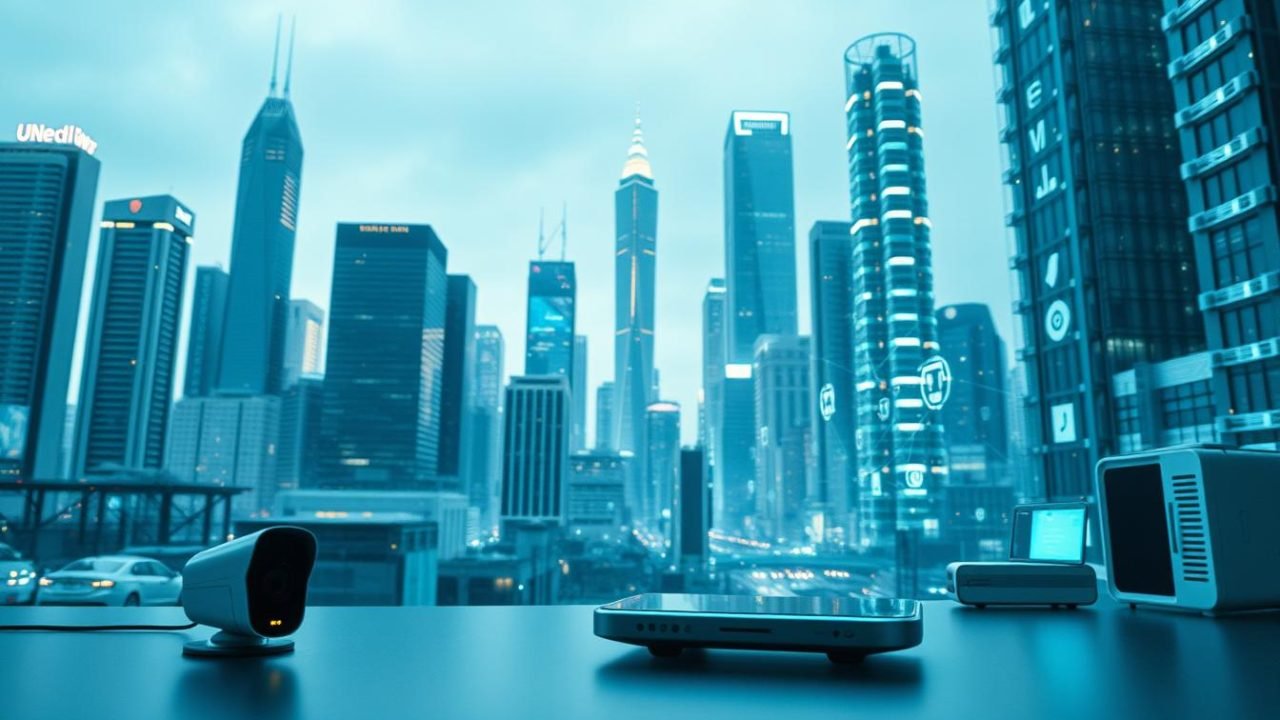We are living in a world that is being transformed by the so-called Internet of Things or IoT. With the advent of the Internet of Things, IoT devices, equipped with sensors and software, make our lives easier. They may be helping in smart homes and industries and making valuable contributions.
There is a quite larger scale growth of IoT in India. Energy — Companies leverage smart technology to enhance efficiency. And not only for homes — healthcare, transport, etc.
Let’s dive into IoT. We’ll see its history, trends, and future. We’ll also discuss its benefits and challenges. How IoT will enhance our living?
Introduction to IoT
The Internet of things connects physical devices and things. They exchange data, transforming our living and working conditions. It is important to understand the place of IoT in the modern technology world.
Key Takeaways
Internet of things is a network of physical devices which accesses and transfers data from device to device.
These cooled IoT devices contain integrated sensors, software, and connectivity.
Smart technology is radically altering our lifestyle and working methods.
IoT finds applications in numerous sectors including healthcare, transportation, and manufacturing.
The IoT Revolution: Changing Modern Technology and Society
From the use of smart-home devices to the application of internet of things in manufacturing, IoT devices are increasing the efficiency and productivity of mills, factories, and operations in several industries.
What You Need to Know About the Internet of Things
Actions: The main components IoT systems can be divided into:
Devices – These are the physical objects that are connected through the internet.
CONNECTIVITY: It’s the communication protocols that allow devices to share data with one another and the cloud.
Data processing (what are you doing with an IoT device): Data processing, for instance, is the analysis of information bugging out from devices, it implies how you can create insights or interpretation of all that data collected from devices in a high-speed manner.
User interface: This is the interface through which users interact with IoT systems, e.g. a mobile app, web interface or a voice assistant.

By learning how these components work in tandem, we can tap into the entire IoT technology to run with appropriate smart solutions. Such solutions make our daily lives easier. In this series of articles, we will take a look at IoT and its Use Cases. We will explore how they are revolutionizing industries and our everyday life.
How Connected Devices Have Evolved in India
The Internet of Things (IoT) in India is experiencing a rapid growth in the adoption of IoT devices and IoT solutions. This is due to government support, new technology and an increasing demand for smart tech. IoT in India is growing at a rapid speed, and the country is becoming a key global player in the IoT scene.
And there are multiple reasons contributing to this increase of connected devices in India. These include:
IoT usage on the rise due to Government initiatives
Increased need for smart technology in various industries
Innovation that drives down the cost of, and increases access to, IoT devices
So, the next few years to come are going to show rapid growth for the Indian market. There’s going to be a significant increase in the number of connected devices. This growth will be fueled by increased IoT adoption in healthcare, education, and manufacturing.

To support this growth we have to overcome challenges such as improving infrastructure and ensuring data security. Until these problems are solved, that we can leverage the full potential of IoT in India. For a more connected and smarter future of the nation.
Key Building Blocks of IoT Architecture
In this case, we are going deep into the heart of IoT systems in terms of the basic building blocks of an IoT system. There are some crucial components in the IOT architecture. These consist of sensors and actuators, gateway devices, cloud platforms, and analytics platforms. Each component plays a critical role in the system’s ability to collect, process, and analyze data.
At the heart of it, there are sensors, which collect the data from the environment. Then actuators act based on that information. These components represent the foundation of the IoT architecture, allowing the system to function. Then, sensitive cloud connection devices collect data from these sensors and save it.
The cloud is central to this, in that it provides storage and processing power for all the data that IoT devices create. It enables vast and flexible IoT systems. It means that data can be easily managed and analyzed.
Key Components of IoT Architecture
- Sensors and actuators
- Gateway devices
- Cloud infrastructure
- Analytics platforms
In the IoT architecture, sensors, cloud, analytics platforms work in coordination. They represent a complete and coherent system. After understanding the fundamental building blocks in IoT architecture, we can appreciate the complexity and potential IoT systems. It reveals how they can spur innovation and enhance much of the economy.
An Introduction to IoT Implementation
Defining the goals of IoT implementation journey The benefits sought from IoT projects and the problems to be solved need to be clear. This ensures that our IoT implementation is focused, useful and on course.
The next step is to choose the right devices and platforms. We choose the sensors, actuators and gateways that can efficiently gather and transmit data. It’s also important to consider security and scalability.” Our systems need to process larger amounts of data and protect ourselves from threats.
Here are some important steps for getting started with IoT implementation:
- Define project goals and objectives
- Select the right devices and platforms
- Ensure security and scalability
- Plan for integration with existing systems
By taking these steps, we’re well-prepared for success. We can create
Key Technologies Powering IoT Solutions
The Internet of things has revolutionized our lifestyles. They impact many industries. So in order to make sense of how IoT works we need to take a look at the major technologies. Among these are wireless communication, data processing, and edge computing.
Wireless Communication Protocols
Protocols such as Wi-Fi, Bluetooth, and cellular networks enable communications between IoT devices. Each of these protocols has strengths and weaknesses of its own. Wi-Fi is ideal indoors, while cellular is more suited for outdoor use, for example.
Data Processing Systems
Data systems, like cloud and fog computing, are key in IoT. They handle the huge amounts of data from IoT devices. This gives us real-time insights for better decisions. Cloud computing stores and processes data, while fog computing does it quickly at the network’s edge.
Edge Computing Infrastructure
In Internet of Things, fast decision making in real time is crucial and, therefore, edge computing is essential. It tailors data processing according to where it is produced, taking the load off cloud systems. This is important for quick applications similar to smart manufacturing and urban advancement projects.
Security Considerations for IoT Deployment
As we add more IoT devices to our lives, security considerations are key. We must plan carefully to keep IoT devices and systems safe. They can face threats like hacking and data breaches.
Important security steps for IoT include:
- Device authentication and authorization
- Data encryption and protection
- Regular software updates and patching
- Network security and segmentation
As we increase IoT use, we need to consider risks and how to mitigate them. By doing this, we can take full advantage of the IoT technology and make our world more connected and safer.
Practical Applications in Indian Industries
IoT is changing many Indian industries in big ways. It has many uses, from smart manufacturing to agricultural IoT solutions. This shows how IoT is changing how industries work.
IoT is Improving Things in smart manufacturing It employs sensors to monitor and manage production. It allows people to observe events as they happen and resolve issues before they become problems.
And agricultural IoT enables farmers to grow and waste less food. It is used for applications such as precision farming and monitoring livestock. This stands to show the way infrastructure of IoT is improving farming.
New Era: Smart Mufacturing | Smart Factory
Agricultural IoT solutions to increase crop yields and decrease waste
Smart cititation: Urban development projects
IoT Is Transforming Industries and Daily Life.
Overcoming Common IoT Implementation Challenges
Setting up IoT solutions can be tricky. We face IoT challenges like making sure devices stay connected and handling lots of data. This is all about data management.
To solve those problems, we need to know what’s causing it. Then we can find ways to address them. This includes:
Resolving connectivity challenges to stabilize networks
Building robust data management systems in order to handle IoT data.
It is a concept for growth and integration in IoT systems
Addressing these IoT problems early on allows organizations to get their IoT implementations right. This allows them to innovate and grow using IoT technology.
Best Practices for IoT Project Management
IoT projects necessitate a structured and systematic management approach. That involves making concrete plans, analyzing potential obstacles, and tracking outcomes. Following these steps helps in successful management of IoT projects.
So here it is: Just some key aspects of IoT project management.
Formulating specific goals and objectives
Performing risk assessment and mitigation planning
Setting up a strong monitoring and evaluation framework
Maintaining appropriate team supervision and stakeholder engagement
Creating an in-depth budget and resource plan
This allows enterprises to succeed in fast changing IoT landscape. This approach prepares them for the unique challenges and opportunities of IoT projects.
Measuring IoT Success and ROI
We monitor key performance indicators (KPIs) to determine if IoT projects are performing. Device Online Frequency, Amount of Data Sent, and User Interactions with the System. Monitoring these KPIs indicates whether the project is performing well and is a worthy investment.
Defining KPIs
Choosing the right KPIs is key to measuring IoT success. Some common ones are:
- Device connectivity and uptime
- Data transmission and reception rates
- User engagement and adoption rates
- System latency and response times
Analytics and Reporting
Analytics and reporting tools are a must to understand how well IoT systems operate. We obtain the data from these tools, and we are able to identify the opportunities for improvement. This ensures that the IoT project continues to perform well and deliver optimum ROI.
KPI tracking and analytics tools allow us to see how IoT projects perform. This ensures that they can achieve their objectives. This also lays a solid foundation for any IoT projects down the track.
The Future Evolution of Internet of Things Technology
To know what the future holds, IoT Evolution in 2024 Emerging technologies like artificial intelligence, blockchain and 5G will enhance the talents of IoT. According to IoT experts, the world of the Internet of Things is set to experience a huge transformation due to the increase in the demand of connected devices and smart solutions.
There are some significant trends such as AI and machine learning, Blockchain for securing data, and 5G for enhancing connectivity. New opportunities will emerge with these new technologies. The global IoT market is projected to surge with more sectors getting on the bandwagon.
As new solutions emerge on the horizon, the IoT industry is on the move.The IoT industry is on the move, with fresh solutions on the horizon. Riding on new tech, market predictions mark a silver lining ahead. The future is certainly bright and promising for IoT, with the increase in demand for connected devices.
Environmental Impact of IoT Solutions
IoT things are growing as we are using IoT solutions, and we need to consider the impact in terms of environmental impact. With its ability to conserve energy and decrease waste, IoT can enables us to be more sustainable. However, producing and using IoT devices generates e-waste and carbon emissions as well.
We need to make IoT sustainable to minimize these adverse effects. That means having devices that use less energy, designing for recyclables, and making sure the disposal mechanisms are responsible.
Here are a few ways to make IoT a greener place:
Reduce energy consumption of IoT devices
Consider recycling in IoT devices
Build systems that are less wasteful
Only by taking into account the environmental implications IOT can we reap the benefits of IOT without doing damage to the planet. In this way we contribute to a greener future and enable IoT to continue improving our lives.
Conclusion
The rapid evolution of the Internet of Things (IoT) is about to revolutionize our world. It is already enhancing—considerably—in smart manufacturing, urban planning and more. Across India, the IoT is boosting industry and improving our lives.
In previous articles, we took a look at what IoT is and how it works. But there’s more to come. New tech like 5G and AI will deliver even more awesome stuff. We’ll see better connections and smarter decisions that transform the way we live.
But, we should also consider the negative aspects. Like protecting our data and not destroying the planet. If we get it right, IoT can create a better world for us all.


